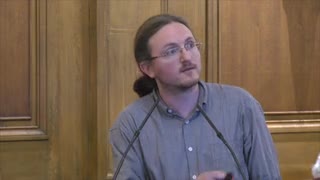- Title:
Stochastic interactions in ecological dynamics: microscopic models, macroscopic approximations and inference - Abstract:
Interactions between individuals, whether of the same or different species, drive ecological dynamics through mechanisms such as competition, predation, or mutualism. In most dynamical models, including the well-known Lotka-Volterra equations, the mathematical form of interaction rates is often chosen without justifications about the underlying biological processes. This leads to both theoretical and empirical challenges: implicit assumptions are made regarding time, space, and system scales, and it becomes difficult to estimate the parameters of these functional forms from data. In this talk, I will present an alternative approach: first, we develop stochastic microscopic models that describe individual-level interactions—for example, between predator and prey; second, we derive approximations for the distributions of interaction rates; and finally, we use these approximations to estimate parameters and perform inference from experimental data. - Affiliation:
Evo-Eco-Paléo UMR CNRS 8198 – University of Lille
- Title:
Scaling limits of individual-based models in adaptive dynamics and local extinction of populations - Abstract:
Starting from an individual-based birth-death-mutation-selection model of adaptive dynamics with three scaling parameters (population size, mutation rate, mutation steps size), we will describe several scaling limits that can be applied to this model to obtain macroscopic models of different natures (PDE, Hamilton-Jacobi equation, stochastic adaptive walks, canonical equation of adaptive dynamics), which allow to characterize the long-term evolution of the population. Motivated by biological criticisms on the time-scale of evolution and the absence of local extinctions in the obtained macroscopic models, we propose new parameter scalings under which we can characterize the evolution of population sizes of the order of Kβ, where K is the order of magnitude of the total population size, and which allows for local extinction of subpopulations. - Affiliation:
Team SIMBA, Institut Elie Cartan de Lorraine, Université de Lorraine (France)
- Title:
Circadian clocks: characterization of cycle dynamics and synchronization in a network of oscillators - Abstract:
Mammalians and other living organisms have evolved a circadian timing system to synchronize their physiology and behavior with the Earth’s light/dark cycle. The core mechanism underlying circadian rhythms is a gene regulatory network consisting of about 5 genes whose expressions oscillate with a period around 24 hours. This genetic network is present in every cell of our body, including in peripheral organs such as the liver. The interactions in a network of intercellular clocks are still very poorly understood, but disrupted or desynchronized circadian rhythms are typically associated with disease.To study the coupling between two or more clocks, their synchronization and final period, as well as emergent dynamical properties in a network, we constructed and calibrated a mathematical model of the mammalian circadian clock based on its core proteins. We then used the framework of piecewise linear differential systems to simplify the model and develop methods to analyze and systematically characterize the dynamics and the period of a single oscillator or a network of oscillators. - Affiliation:
Team MacBes, Inria center at Université Côte d’Azur (France)
- Title:
TBA - Abstract:
TBA - Affiliation:
Laboratoire J.A. Dieudonné, Université Côte d’Azur (France)
- Title:
Inside dynamics of travelling waves in reaction-dispersion models for ecology and evolution - Abstract:
The inside dynamics approach describes the mesoscopic behaviour of solutions to reaction–dispersion equations. Rather than tracking every individual, it captures the dynamics of neutral groups within a population. In this talk, I will present results on the inside dynamics of travelling wave solutions in reaction–dispersion models, which arise in many ecological and evolutionary contexts. These results shed new light on the genetic consequences of biological invasions and species range shifts under environmental change, the genealogy of populations in fluctuating environments, and the mechanisms driving colonization and recolonization of landscapes by multiple species. - Affiliation:
Laboratoire de Mathématiques (LAMA) at Université Savoie Mont-Blanc (France)
- Title:
Large-population limits of non-exchangeable particle systems - Abstract:
“Interacting particle systems” denote a large family of microscopic models describing how local interactions between many individuals (or “particles”) may eventually lead to collective behavior. Such models originated from statistical physics, in which it can be reasonable to assume that the particles are identical, i.e. exchangeable. However, increasing evidence suggests that some systems’ heterogeneity (as they are composed of inherently non-exchangeable individuals) affects their collective behavior. One way to model the interactions between non-exchangeable particles is to consider that they are dictated by an underlying graph.
One of the main drawbacks of the microscopic formulation of an interacting particle system (through a system of coupled ODEs) is its computational cost, which can rapidly become unmanageable as the number of particles becomes large. The mean-field limit provides an alternative macroscopic description of the system when the population is infinitely large and the particles are exchangeable. Instead of focusing on the individual trajectories of the particles, its central idea consists of focusing on the evolution of the population density, which solves a Vlasov-type equation.We present two approaches to derive the macroscopic limit for a non-exchangeable particle system: the non-exchangeable mean-field limit and the continuum limit. Both of them rely on the concept of “graphon”, which generalizes the concept of graph to infinitely many nodes. We introduce the main ideas behind both limits, focusing in particular on the cases of random graphs and hypergraphs. - Affiliation:
Team MUSCLEES at Inria Paris (France) and at the Jacques-Louis Lions Laboratory at Paris Sorbonne University (France)
- Title:
Opinion formation and control - Abstract:
There is a large literature on opinion formation models; in many of them the dynamics are driven by binary interactions between individuals that are modulated by an underlying (social) network structure. In this talk I will discuss different mathematical modeling approaches in this setting, and how we can derive partial differential equation models in suitable scaling limits. Furthermore I will focus on the question of opinion control; in particular the question of how one can steer an opinion towards a desired target or prevent consensus. - Affiliation:
Mathematics Institute at the University of Warwick (United Kingdom)







